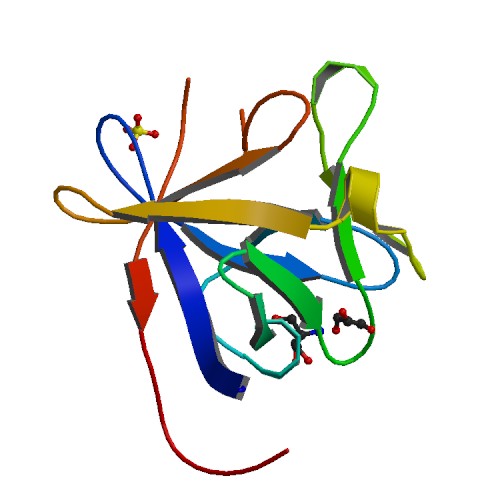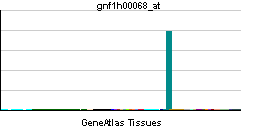FGF19
| Fibroblast growth factor 19 | |||||||||||||
|---|---|---|---|---|---|---|---|---|---|---|---|---|---|
 PDB rendering based on 1pwa. | |||||||||||||
| |||||||||||||
| Identifiers | |||||||||||||
| Symbols | FGF19 ; | ||||||||||||
| External IDs | Template:OMIM5 Template:MGI HomoloGene: 3754 | ||||||||||||
| |||||||||||||
| RNA expression pattern | |||||||||||||
 | |||||||||||||
| More reference expression data | |||||||||||||
| Orthologs | |||||||||||||
| Template:GNF Ortholog box | |||||||||||||
| Species | Human | Mouse | |||||||||||
| Entrez | n/a | n/a | |||||||||||
| Ensembl | n/a | n/a | |||||||||||
| UniProt | n/a | n/a | |||||||||||
| RefSeq (mRNA) | n/a | n/a | |||||||||||
| RefSeq (protein) | n/a | n/a | |||||||||||
| Location (UCSC) | n/a | n/a | |||||||||||
| PubMed search | n/a | n/a | |||||||||||
Fibroblast growth factor 19, also known as FGF19, is a human gene.[1]
The protein encoded by this gene is a member of the fibroblast growth factor (FGF) family. FGF family members possess broad mitogenic and cell survival activities, and are involved in a variety of biological processes including embryonic development cell growth, morphogenesis, tissue repair, tumor growth and invasion. This growth factor is a high affinity, heparin dependent ligand for FGFR4. Expression of this gene was detected only in fetal but not adult brain tissue. Synergistic interaction of the chick homolog and Wnt-8c has been shown to be required for initiation of inner ear development.[1]
References
Further reading
- Nishimura T, Utsunomiya Y, Hoshikawa M; et al. (1999). "Structure and expression of a novel human FGF, FGF-19, expressed in the fetal brain". Biochim. Biophys. Acta. 1444 (1): 148–51. PMID 9931477.
- Xie MH, Holcomb I, Deuel B; et al. (1999). "FGF-19, a novel fibroblast growth factor with unique specificity for FGFR4". Cytokine. 11 (10): 729–35. doi:10.1006/cyto.1999.0485. PMID 10525310.
- Ladher RK, Anakwe KU, Gurney AL; et al. (2000). "Identification of synergistic signals initiating inner ear development". Science. 290 (5498): 1965–7. PMID 11110663.
- Tomlinson E, Fu L, John L; et al. (2002). "Transgenic mice expressing human fibroblast growth factor-19 display increased metabolic rate and decreased adiposity". Endocrinology. 143 (5): 1741–7. PMID 11956156.
- Nicholes K, Guillet S, Tomlinson E; et al. (2002). "A mouse model of hepatocellular carcinoma: ectopic expression of fibroblast growth factor 19 in skeletal muscle of transgenic mice". Am. J. Pathol. 160 (6): 2295–307. PMID 12057932.
- Strausberg RL, Feingold EA, Grouse LH; et al. (2003). "Generation and initial analysis of more than 15,000 full-length human and mouse cDNA sequences". Proc. Natl. Acad. Sci. U.S.A. 99 (26): 16899–903. doi:10.1073/pnas.242603899. PMID 12477932.
- Katoh M, Katoh M (2004). "Evolutionary conservation of CCND1-ORAOV1-FGF19-FGF4 locus from zebrafish to human". Int. J. Mol. Med. 12 (1): 45–50. PMID 12792807.
- Holt JA, Luo G, Billin AN; et al. (2003). "Definition of a novel growth factor-dependent signal cascade for the suppression of bile acid biosynthesis". Genes Dev. 17 (13): 1581–91. doi:10.1101/gad.1083503. PMID 12815072.
- Clark HF, Gurney AL, Abaya E; et al. (2003). "The secreted protein discovery initiative (SPDI), a large-scale effort to identify novel human secreted and transmembrane proteins: a bioinformatics assessment". Genome Res. 13 (10): 2265–70. doi:10.1101/gr.1293003. PMID 12975309.
- Harmer NJ, Pellegrini L, Chirgadze D; et al. (2004). "The crystal structure of fibroblast growth factor (FGF) 19 reveals novel features of the FGF family and offers a structural basis for its unusual receptor affinity". Biochemistry. 43 (3): 629–40. doi:10.1021/bi035320k. PMID 14730967.
- Fu L, John LM, Adams SH; et al. (2004). "Fibroblast growth factor 19 increases metabolic rate and reverses dietary and leptin-deficient diabetes". Endocrinology. 145 (6): 2594–603. doi:10.1210/en.2003-1671. PMID 14976145.
- Popovici C, Conchonaud F, Birnbaum D, Roubin R (2004). "Functional phylogeny relates LET-756 to fibroblast growth factor 9". J. Biol. Chem. 279 (38): 40146–52. doi:10.1074/jbc.M405795200. PMID 15199049.
- Zhang Z, Henzel WJ (2005). "Signal peptide prediction based on analysis of experimentally verified cleavage sites". Protein Sci. 13 (10): 2819–24. doi:10.1110/ps.04682504. PMID 15340161.
- Gerhard DS, Wagner L, Feingold EA; et al. (2004). "The status, quality, and expansion of the NIH full-length cDNA project: the Mammalian Gene Collection (MGC)". Genome Res. 14 (10B): 2121–7. doi:10.1101/gr.2596504. PMID 15489334.
- Tamimi Y, Skarie JM, Footz T; et al. (2006). "FGF19 is a target for FOXC1 regulation in ciliary body-derived cells". Hum. Mol. Genet. 15 (21): 3229–40. doi:10.1093/hmg/ddl400. PMID 17000708.
- Goetz R, Beenken A, Ibrahimi OA; et al. (2007). "Molecular insights into the klotho-dependent, endocrine mode of action of fibroblast growth factor 19 subfamily members". Mol. Cell. Biol. 27 (9): 3417–28. doi:10.1128/MCB.02249-06. PMID 17339340.
- Wu X, Ge H, Gupte J; et al. (2007). "Co-receptor requirements for fibroblast growth factor-19 signaling". J. Biol. Chem. 282 (40): 29069–72. doi:10.1074/jbc.C700130200. PMID 17711860.
| This protein-related article is a stub. You can help Wikipedia by expanding it. |